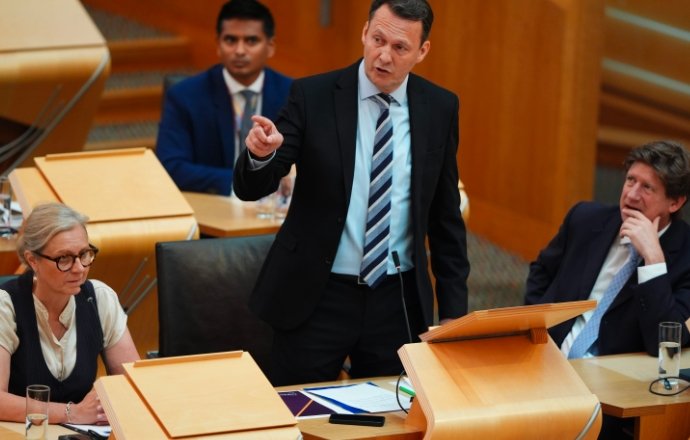Business leaders in Scotland have urged politicians to avoid widening the tax gap with the rest of the UK as the country heads toward the 2026 Holyrood elections. The Scottish Retail Consortium shared its economic manifesto with MSPs, stressing the need for growth focused policies over new taxes that could hurt firms and workers.
Why the Tax Gap Concerns Scottish Businesses
The tax gap between Scotland and the rest of the UK has grown over recent years due to devolved powers that let Holyrood set its own income tax rates and bands. This divergence means many Scots pay more in taxes than people earning the same in England or Wales, especially those in higher income brackets. Business groups worry that further changes could slow economic growth and push companies to relocate south of the border.
Experts point out that freezing tax thresholds in past budgets dragged thousands of workers into higher rates without adjusting for inflation. For the 2025 to 2026 tax year, the higher rate in Scotland kicks in at just over 43,000 pounds, while it starts at around 50,000 pounds elsewhere in the UK. This setup has led to concerns about fairness and competitiveness, with some reports showing an economic performance gap of over 1 billion pounds in potential income tax revenue if Scotland matched UK averages.
Recent data from fiscal watchdogs highlights how these differences affect public finances. Scotland’s budget faces pressures from rising welfare costs, now at 1.3 billion pounds more than UK funding, a figure expected to climb to 2.2 billion by the end of the forecast period. Leaders argue that instead of raising taxes, the focus should shift to boosting employment and earnings to close this gap naturally.

Key Points in the Retail Consortium’s Manifesto
The Scottish Retail Consortium laid out clear demands in its manifesto to help the economy thrive after next year’s elections. They called for parties to unite on pro growth measures that benefit businesses, workers, and public services alike.
One major push is to keep income tax policies aligned with the UK to avoid more divergence. The group wants thresholds for each tax band to rise each year with inflation, preventing stealth tax hikes on everyday earners. They also seek a competitive business tax system that encourages investment without adding burdens.
In addition, the manifesto highlights the need for local checks on council tax increases. Firms should gain more say over apprenticeship funding, and no extra tax powers should go to local authorities without full reviews of public sector efficiency.
- Avoid new local taxes or levies on businesses until independent audits of councils and public bodies occur.
- Hold referendums for any council tax hikes over five percent to give communities a voice.
- Promote economic growth as the best way to fund services and raise living standards.
These steps aim to remove barriers that hold back retail and other sectors, which employ hundreds of thousands across Scotland.
Political Responses to the Warning
Scottish politicians have started reacting to the business leaders’ call, with debates heating up ahead of the 2026 vote. Conservative MSPs praised the manifesto as a stark reminder of economic stagnation risks if taxes rise further.
Opposition figures like Murdo Fraser stressed that ministers must listen to the retail industry, which drives jobs and investment. They point to polling data showing 40 percent of Scots oppose giving councils new tax powers, compared to just 29 percent in favor. This public sentiment adds weight to the argument against quick changes.
On the government side, officials defend past tax decisions as ways to protect frontline services amid tight budgets. Yet, with the UK Labour budget adding 3.4 billion pounds to devolved spending, there’s talk of more room for growth focused policies. Parties across the board are eyeing the elections, where tax and spending will be hot topics.
Recent events, like the push for council tax reform from local leaders, show broader agreement on the need for balance. Cosla, the council body, urged parties to overhaul the system before the vote, linking it to fairer funding for services.
Comparing Income Tax Bands in Scotland and the Rest of the UK
To understand the current tax landscape, it’s helpful to look at the differences in income tax bands for the 2025 to 2026 year. Scotland now has six bands, making its system more complex and progressive than the UK’s three main ones. This table breaks down the key rates and thresholds, showing how the gap plays out for different earners.
| Income Band | Scotland Threshold (Pounds) | Scotland Rate (%) | UK Threshold (Pounds) | UK Rate (%) | Difference for High Earners |
|---|---|---|---|---|---|
| Starter | Up to 12,570 | 19 | Up to 12,570 | 19 | None |
| Basic | 12,571 to 14,876 | 20 | 12,571 to 50,270 | 20 | Scotland ends basic earlier |
| Intermediate | 14,877 to 26,561 | 21 | N/A | N/A | Extra band in Scotland |
| Higher | 26,562 to 43,662 | 42 | 50,271 to 125,140 | 40 | Starts 6,609 pounds lower, 2% higher |
| Advanced | 43,663 to 75,000 | 45 | N/A | N/A | New band widens gap |
| Top | Over 75,000 | 48 | Over 125,140 | 45 | Much higher rate in Scotland |
This comparison reveals why business leaders fear more divergence. For someone earning 50,000 pounds, they pay about 763 pounds more in Scotland than in the rest of the UK. At 200,000 pounds, the difference jumps to over 7,000 pounds annually, fueling worries about talent and business flight.
Fiscal experts note that while low earners might see slight benefits from top ups to benefits, the overall system takes more from middle and higher incomes. This progressivity has helped fund services but at the cost of widening the fiscal gap with the UK.
Impacts on Workers and the Economy
The push to keep the tax gap in check comes amid broader economic challenges in Scotland. Stagnant growth compared to other UK regions has left earnings lagging, with recent reports showing a 1.06 billion pound shortfall in potential tax revenue.
Workers in retail and other sectors feel the pinch from higher effective taxes, which could mean less take home pay or incentives to move. Businesses warn that new local taxes would add to costs already strained by inflation and supply issues.
On the positive side, aligning policies could spark investment. The retail sector, employing over 200,000 Scots, stands ready to drive jobs if barriers lift. Recent UK wide changes, like National Insurance cuts saving average workers 800 pounds, show how balanced approaches help everyone.
Yet, without action, the gap might grow. Projections indicate borrowing limits could be hit by 2027 if trends continue, forcing tough choices on spending.
Looking Ahead to Growth and Elections
As the 2026 Holyrood elections near, the debate on taxes will shape voter choices. Business leaders like David Lonsdale from the Scottish Retail Consortium emphasize that growth is the key to better services and higher standards.
Parties must work together on budgets that prioritize expansion over hikes. With extra UK funding in play, there’s a chance to invest in skills and infrastructure without raising burdens.
Readers, what do you think about balancing taxes and growth in Scotland? Share your views in the comments below and spread the word by sharing this article with friends and colleagues to keep the conversation going.


















